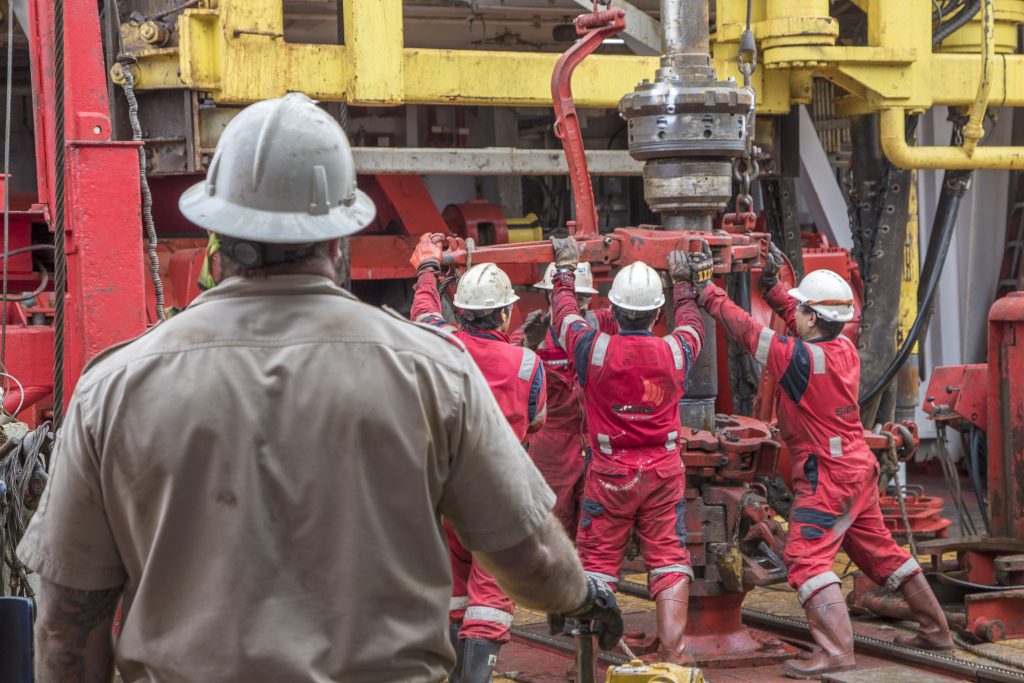Preface
Images of JOIDES Resolution (Credit: L. Guertin, IODP EXP 390, CC BY-NC 4.0)
Our OER
Overarching Goal: After reading through and engaging with the material presented in this OER, students will understand the process of scientific ocean drilling and its context in oceanographic discovery and exploration, past and present.
Welcome to our Open Educational Resource (OER) focused on scientific ocean drilling and its contributions to our knowledge of ocean science and overall Earth systems. Our project team, all former JOIDES Resolution Onboard Outreach Officers with formal and informal education experience, have authored this book for an introductory-level, non-STEM student audience at the university level, as well as individuals curious to increase their scientific and oceanic literacies.
This OER is not looking to replace existing oceanography textbooks but to serve as a supplement in introduction to oceanography courses at the university level, where existing OER materials are significantly reducing or no longer including content on the history and process of science, especially at sea. Each section of our book has its own learning objectives, with the supporting pages providing opportunities for students to check and apply their knowledge.
We are excited to be using the Pressbooks authoring platform , which allows us to utilize existing scientific ocean drilling multimedia and to design new interactive materials that align with best pedagogical practices. The design of the book addresses accessibility for assistive technologies and inclusion of science identities for student users. In addition, our OER can be incorporated into existing and future OER books by other instructors. As this book is freely available for anyone to access, we know our OER has the potential to increase public literacy in ocean science beyond classroom utilization.
The Increase of OER Textbooks, with a Decrease of Ocean Content
Currently, the availability of OER textbooks for introductory-level oceanography courses at the university level are very limited. A research project conducted by two student researchers at Penn State Brandywine in Fall 2022 found only five introductory oceanography OER textbooks. Of these five books, only two mention Glomar Challenger (which is misspelled as Golmar Challenger) and JOIDES Resolution (Catalano et al., 2023). Their project results documented that these OER introductory oceanography books are lacking chapters or significantly reduce discussions typically found in print textbooks on the history of oceanography and the technologies used as well as the overall process of science at sea.
The lack of attention to the history of science is a point of concern, as instruction relating to the history of science has even been stripped from K-12 science standards in the United States. Where the National Science Education Standards from 1996 included the History and Nature of Science as one of the eight required focus areas for instruction (National Research Council, 1996), the updated Next Generation Science Standards (NGSS) released in 2013 no longer require any teaching of previous scientists or science discoveries (National Research Council, 2013). With the United States challenged to maintain the same level of leadership and participation in scientific ocean drilling past 2024 with the conclusion of the International Ocean Discovery Program (IODP), the activities of JOIDES Resolution and prior drill ships become part of the history of science and therefore likely not to be included in classroom lectures or textbooks at any grade level. Note this is not to say that the research contributions and discoveries resulting from continuous cores drilled across the globe are not included in textbooks, but that the mechanism and process of how the material was obtained will be absent. This OER will serve as an important and valuable supplement to oceanography instruction to ensure that history and technology are still presented to students.

Audience
We are not seeking to write a book that serves as a history and overview of all of scientific ocean drilling – we know those books exist and are still being written for general audiences (see our Books and Reports page). Our audience is different, as this OER is not targeted specifically for readers with a general interest in this subject, or for professionals in the field of scientific ocean drilling. We are aiming to have our primary audience be university educators and their students. Certainly, with the Pressbook platform being open access, anyone will have the opportunity to engage with our book, and teachers of younger grades as well as informal educators may find use and application of our material. But with each page in the book designed with best pedagogical practices, interactive check points and assessments, and informed by our own teaching backgrounds, this OER will have an educational approach and presentation of material for students. Educators have the flexibility for students to engage with the content during a class or outside of class time. The online, interactive material we include maintains the focus of students as they progress through each topic.
The Authors
The three authors of this Open Educational Resource – Laura Guertin, Elizabeth Doyle, Tessa Peixoto – are former Onboard Outreach Officers that sailed on JOIDES Resolution between 2022 and 2024. It is from our training and experiences as formal and informal educators, our time on board the ship, and our continued connections and collaborations within the scientific ocean drilling community that we have tapped into our backgrounds and have written this narrative on the ships, the technology, the discoveries, and the people. We provide additional information about ourselves on the About the Authors page at the end of this OER.

